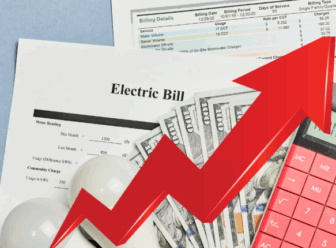By Steven Mufson
When Maryland and the District set floors requiring electric utilities to use increasing amounts of renewable energy, environmentalists cheered the prospect of money going to new solar and wind projects.
But today, several years after the legislation went into effect, it has had an unexpected outcome.
Thanks to a wrinkle in the definition of renewable, the lion’s share of the money used to meet those standards is flowing to paper companies that burn “black liquor,” a byproduct of the wood-pulping process. Paper mills have been using black liquor to generate most of their power needs since the 1930s.
Environmentalists are up in arms over what they see as a perversion of the intent of the law. Instead of encouraging new clean technology, they say, it is rewarding an old practice that emits as much carbon dioxide as burning coal.
“When the renewable portfolio standard first passed, it was unknown how much [black liquor] would get into it,” said Mike Tidwell, head of the Chesapeake Climate Action Network, who appeared smiling in a photo of the signing ceremony when the measure first became law. “It turned out to be a lot, and it’s time for it to come out.” He added, “It’s time for Maryland to stop contributing to that rip-off. Black liquor is the pink slime of energy in this state.”
But lobbyists for the paper companies say that black liquor should be treated the same as any other biofuel.
“It’s biomass. If you don’t burn it, you put it in a landfill or throw it in the ocean,” said Bill Pitcher, who, as a lobbyist for the Luke mill in western Maryland, helped negotiate the language in the bill. “It’s not a pollution thing. It’s an energy thing.”
The dispute echoes an earlier fight in Congress over black liquor. In 2009 and 2010, the country’s largest paper companies were able to get black liquor qualified as an “alternative fuel” and the Treasury ended up paying out several billion dollars to some of the country’s biggest paper companies. International Paper alone received $1.7 billion in cash in 2009 from the refundable tax credit, which expired at the end of that year. Paper companies later collected more federal tax breaks for biofuels, another provision that ended.
The amounts of money at stake in state renewable portfolio laws are tiny by comparison. But paper companies have managed to take advantage of renewable energy laws in many states around the country, and Maryland and District electricity rate-payers are effectively funneling several million dollars a year to paper companies that burn black liquor.
Maryland’s complex renewable energy law, adopted in 2005, requires utilities to buy certain minimum percentages of their electricity from renewable sources, starting at 2 percent and rising to 20 percent by 2020. Utilities can meet those minimums, or quotas, by buying electric power from renewable sources or by buying credits from companies that generate power from renewable sources.
The D.C. version of the law, known as renewable portfolio standard law, is virtually identical.
In the fine print, the laws say that “mill residue” is a “qualifying biomass” to be counted as a renewable energy source. That means paper mills that burn black liquor to run their operations can simultaneously make money selling renewable-energy credits to utility companies.
Although the amount of money at stake is small now, some experts say that payments could grow tenfold or more in the next few years.
Many environmental activists want the law revised to plug what they see as a gaping loophole, and Maryland Sen. Robert J. Garagiola (D-Montgomery) and Del. John A. Olszewski (D-Baltimore County) have been working on a fix.
“This situation is undesirable both because the energy from these sources is not significantly cleaner than that from the burning of fossil fuels, and because the facilities that supply these credits were all in existence for years before the law was enacted, with the result that purchase of credits from these sources is not encouraging investment in new more efficient renewable energy facilities,” said Maryland Assistant Attorney General Kathryn M. Rowe in a Jan. 3 letter to Olszewski.
A complicated system
A bill to change the law has 13 co-sponsors in the Maryland House, including a majority of the Economic Matters Committee, which has scheduled a hearing March 7. The Senate Finance Committee has a hearing scheduled March 5. The District hasn’t yet drafted a new measure.
The Maryland changes would immediately curtail benefits for all but two of the seven paper mills that have benefitted from the program. The Luke mill, which employs 860 people, is the only one located in Maryland. The revised law would phase out benefits for the Luke mill and a mill in Covington, Va., in 2018. Given that assurance, Luke mill manager Richard J. Watro said in a letter that the company “does not intend to oppose” the bill.
The revised law would alter a complicated system that has two levels — or tiers — of requirements, with the first including wind and solar. The second, lower-priority category, includes hydroelectric power. But the top category also includes a grab bag of other sources, including methane from landfills, ocean tidal projects and “qualifying biomass.”
“Our industry is an important part of the renewable energy story, which 22 other states in the country recognize by qualifying our biomass-based energy in their Renewable Portfolio Standards or goals,” said Jessica McFaul, a spokesman for the American Forest and Paper Association.
But the share of renewable-energy credits going to paper companies is much higher in Maryland and the District than in other states. In Maryland in 2010, paper mills burning black liquor provided 42.8 percent of credits used to meet the tier-one requirements, according to a report by the state. And 58 percent of the new credits purchased to meet future standards came from those paper mills.
In 2011, a third of the credits used to meet the top category’s standards came from black liquor.
In the District, 70 percent of the credits in 2010 and 42 percent in 2011 used to meet tier-one renewable standards came from black liquor operations.
In states that have barred the use of black liquor credits, such as New Jersey and Delaware, about three quarters of the tier-one credits have helped wind projects, according to James McGarry, a policy analyst at the Chesapeake Climate Action Network. There are renewable-electricity standards in 29 states, two territories and the District.
Virginia’s targets are voluntary. But Virginia utility regulators, the State Corporation Commission, have granted bonus rate increases to Dominion Resources and Appalachian Power that Chesapeake Climate Action Network estimates will mean $91 million in extra revenue in return for hitting renewable energy goals.
Potential windfall
The size of the Maryland and District payments to black liquor makers is modest for now.
Baltimore Gas & Electric paid about $2.75 for every renewable energy credit, according to Maryland records. At that rate, the renewable energy credits generated in the entire state for the year 2010 would have been worth $7.5 million. In 2011, about $3 million probably went to black liquor producers, McGarry estimates.
But as the renewable requirements scale up to 2020 levels, and as the economy and electricity demand rebound, the price of credits could jump.
Meanwhile, even modest payments could help some paper plants such as the Luke mill, which has invested in upgrading its aging fa
cilities.
“It’s a big deal for this one mill, but in the giant scheme of things, it’s not going to decide whether a windmill farm is going to get developed,” Pitcher said. “What’s the cost-benefit ratio of throwing 100 or 1,200 people out work in counties experiencing the recession?”
Ohio-based NewPage, the current owner of the Luke mill, would not comment.
MeadWestvaco, which owns the Covington Pulp and Paper Mill in Virginia that sells black liquor credits in Maryland, also declined to comment. But the Richmond-based company, which owned the Luke mill before selling it to NewPage in 2005, says on its Web site that 70 percent of its fuel is “renewable.” Although it doesn’t specify, industry analysts say that renewable fuel is virtually entirely black liquor. MeadWestvaco added that it sold 2 percent of this as renewable energy credits. At the rate Baltimore Gas & Electric paid, that would come to about $1.5 million.
McFaul, from the forest-products industry group, said that “although we do not have data to show how much money is collected, we do have some information from member companies indicating that — overall — renewable-energy credit sales represent less than 10 percent of the energy we use.” She added, “Overall, it is not a big source of revenue for the industry. However, for individual mills, it can be, and to remove a significant revenue stream could be harmful to those jobs.”
Local lawmakers who believed the Maryland and D.C. renewable portfolio standards made a difference said questions about the benefits flowing to black liquor have come as a surprise.
“The bottom line as far as I’m concerned: The RPS [Renewable Portfolio Standard] was all about driving the market toward renewable sources of energy, and we need to be going toward clean sources of renewable energy,” said D.C. Council Chairman Phil Mendelson (D), who co-sponsored the renewable energy bill in 2004. “That’s the bottom line, that’s what we need to be driving towards.”
Asked about the language of the bill that included biomass, he said, “You have to think of the context of when we were writing this law. We were in the region at the cutting edge of requiring renewable energy.”
He added, “We expected a lot of opposition from the electric utilities, so we were pushing as far as we could. At first blush, the idea of burning waste to create energy sounds like a good idea. Of course there are a lot of byproducts of the burning that are not good. It was about trying to find that balance to pass the bill. The world has changed a lot over the past decade.”




